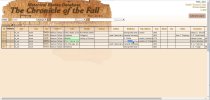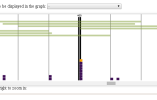Re: Historical Events Database
Yes. The 'old' database was too forgiving in what could be entered. With the goal of making a scholarly, professionally-typeset publication out of it, I now see what has to be changed from a technical perspective.
I've finished migrating the data to the new scheme semi-automatically as good as I could. Right now I'm reviewing a cross-section of entries of ancient authors (Cicero, Livy, etc.) to get a feeling for classical sources (esp. for writing algorithms for automatically generating citation syntax). I'm a bit of a late-comer in this respect. However, I've finished checking all the Cicero entries, and now have a good 'feeling' for all available Cicero's translations and publications, online and in paper. Next I'll look at Livy. I'm using the new database myself as I go along, and therefore it will be well tested and optimized for the next collaboration step in our project. I've found that having an Spreadsheet-like interface for listings greatly eases the work (see screenshot).
It's tedious and slow-coming work. But I hope that at some point you all can come back and help out. I can't say yet when the time comes, maybe 2-3 weeks? Maybe, in the meantime, you can continue reading the sources that you've planned to enter, put sticky tabs into your books, or bookmark texts in your browser, so that you can focus on entering data later.
Once the database is available again, I think we will have to stick to the following work flow:
1. All previously filed events will have to be re-visited by the creator, and then 'Cleared for Review'.
2. Those events 'Cleared for Review' will then have to be 'Reviewed' by another person.
3. Events have to be fixed by the creator or the reviewer until it is considered 'successfully reviewed'.
4. Only 'successfully reviewed' events will be considered for any publications.
5. For the actual publication (on paper and e-book) we might only choose a subset of those successfully reviewed events (one of the reasons is to use paper space better)
Basically, this will be a filtering process. This sounds like a lot of work and hassle (it will be), but I don't see any other way to produce anything of a good quality or coming near to a scholarly work.
Apart from publication in book form, we could make the database available read-only for other researchers, but this is just an idea on the side.
I think I'll need to either make video tutorials, or personal training via Skype...
Stay tuned!
Yes. The Events in the 'old' database were just one table, not relational. This would have been enough if all the fields would have been used uniformly across all contributors -- the autocomplete feature was supposed to help with that. But the fields were not enough, and were used for mixed purposes. All of this will have to be fixed in the new database by all of us.
Now everything is relational, most importantly the tables for Sources, Texts and Events (I'll also add a new table for the Pleiades Project information).
Palinurus said:Thanks for the update, Data. If I understand all this correctly, you're aiming at a completely new level of professionalism for this whole endeavor.
Yes. The 'old' database was too forgiving in what could be entered. With the goal of making a scholarly, professionally-typeset publication out of it, I now see what has to be changed from a technical perspective.
I've finished migrating the data to the new scheme semi-automatically as good as I could. Right now I'm reviewing a cross-section of entries of ancient authors (Cicero, Livy, etc.) to get a feeling for classical sources (esp. for writing algorithms for automatically generating citation syntax). I'm a bit of a late-comer in this respect. However, I've finished checking all the Cicero entries, and now have a good 'feeling' for all available Cicero's translations and publications, online and in paper. Next I'll look at Livy. I'm using the new database myself as I go along, and therefore it will be well tested and optimized for the next collaboration step in our project. I've found that having an Spreadsheet-like interface for listings greatly eases the work (see screenshot).
It's tedious and slow-coming work. But I hope that at some point you all can come back and help out. I can't say yet when the time comes, maybe 2-3 weeks? Maybe, in the meantime, you can continue reading the sources that you've planned to enter, put sticky tabs into your books, or bookmark texts in your browser, so that you can focus on entering data later.
Once the database is available again, I think we will have to stick to the following work flow:
1. All previously filed events will have to be re-visited by the creator, and then 'Cleared for Review'.
2. Those events 'Cleared for Review' will then have to be 'Reviewed' by another person.
3. Events have to be fixed by the creator or the reviewer until it is considered 'successfully reviewed'.
4. Only 'successfully reviewed' events will be considered for any publications.
5. For the actual publication (on paper and e-book) we might only choose a subset of those successfully reviewed events (one of the reasons is to use paper space better)
Basically, this will be a filtering process. This sounds like a lot of work and hassle (it will be), but I don't see any other way to produce anything of a good quality or coming near to a scholarly work.
Apart from publication in book form, we could make the database available read-only for other researchers, but this is just an idea on the side.
I think I'll need to either make video tutorials, or personal training via Skype...
Stay tuned!
Dirgni said:This sounds if you will/could use something like a relational database in the background?
Yes. The Events in the 'old' database were just one table, not relational. This would have been enough if all the fields would have been used uniformly across all contributors -- the autocomplete feature was supposed to help with that. But the fields were not enough, and were used for mixed purposes. All of this will have to be fixed in the new database by all of us.
Now everything is relational, most importantly the tables for Sources, Texts and Events (I'll also add a new table for the Pleiades Project information).



